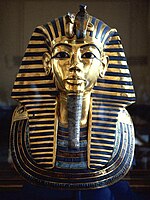 OK, so it's only the B team (the A team exhibit opened at the same time in San Francisco) -- but, Indianapolis is the smallest market to boast an exhibit of "Tutankhamen: The Golden King and the Great Pharaohs". The show opened Saturday (27 June) at the Children's Museum of Indianapolis, 3000 North Meridian Street, Indianapolis, and runs through 25 October. (Photo from Wikipedia)
OK, so it's only the B team (the A team exhibit opened at the same time in San Francisco) -- but, Indianapolis is the smallest market to boast an exhibit of "Tutankhamen: The Golden King and the Great Pharaohs". The show opened Saturday (27 June) at the Children's Museum of Indianapolis, 3000 North Meridian Street, Indianapolis, and runs through 25 October. (Photo from Wikipedia)It's pricey -- adult tix for weekend visits are $30 -- but something you're not likely to see outside Egypt (or, outside the other Tut exhibit touring the U.S.). Surprisingly, it's not a money-maker for the Children's Museum. According to Kathleen McLaughlin's article in The Indianapolis Business Journal this week, proceeds will go first to Arts and Exhibitions International of Aurora, Ohio, the show's for-profit producer. Only when their costs are covered will the museum begin to share in the profits.
However, hosting the show is for more than monetary gain, according to Jeffrey Patchen, the museum's CEO. The publicity around hosting King Tut is priceless, as Indy is the smallest market for either exhibit in the U.S. Being able to host the show stems from the relationship between the Children's Museum and the efforts of Suzanne Mubarak (Egypt's "first lady") to open a museum for children in Cairo. Patchen and other members of the staff have made several visits to Egypt. Indy's museum is consulting -- gratis -- on the "guts" of the Cairo museum: designing the exhibits. Dr. Zahi Hawass, Secretary General of Egypt's Supreme Council of Antiquities, insisted that the Tut show make an Indianapolis stop -- he, himself, came to the opening last weekend.
This Indianapolis Observer was disappointed in the show. Sure, the 120 artifacts (1/3 of which are from King Tutankhamen's tomb) are beyond fabulous, but the signage is minimal. Even the audio guide (an extra $7 for adults) is sketchy, providing sentences of description rather than paragraphs of context for the handful of objects it covers. Egypt's pharoahnic period is far more complex than visitors will learn from this exhibit. Although it's supposed to place King Tut in context, it seems more to magnify his short reign (1333–1324 BCE). Historically, it was a footnote -- it's important primarily because his tomb was one of the few not to be completely plundered by grave robbers over the millennia.
No comments:
Post a Comment